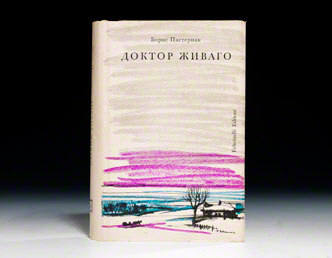
A woman loves two men and loses them both amidst a catastrophic war which sweeps away an entire way of life. A man loves two women and loses them both amidst a war and ensuring revolution which ushers in a world unlike that which existed before. Sound familiar? The first is the basic plot (boiled down for simplicity) of Gone With the Wind while the second is the main plot (also boiled down) of Dr. Zhivago. The films are classics, of course, but the novels are as well. Russian literature in particular has great depth to it. I’ve been able to read Zhivago in the original language, as well as the English translation. And I am proud to own a first edition of Gone With the Wind which belonged to my great-grandmother’s sister.
What interests me about these books when compared to one another is that they explore similar themes, though they were written in different times and places. Gone With the Wind was published first, in 1936, but it is nearly impossible that Pasternak could have read it because it was not published in the Soviet Union until 1982 and the movie was not released there until 1990. The fact that love and loss amidst the backdrop of war serves both books so well speaks to universal human condition and emotion. Just as the Civil War transformed the American South, so too did World War One, the Russian Revolution (really a Civil War of its own), followed by the Red Terror transformed Russia. In both books, you have people trying their best to survive amidst terrible hardships.

I love epics, be they of screen or page. There’s something about a sweeping story which catches you up and brings you along for the ride which appeals to me. Sadly, not everyone feels this way. When I was a young single man, I invited a girl to my apartment to watch a movie and popped in Dr. Zhivago. That was our third date. She declined a fourth. 😊
If you want to take this one step further, Sholokov’s masterpiece Quiet Flows the Don can be compared to the two as well. It is a magnificent epic of Cossack life starting in 1912 and ending in the early 1920s. It also involves the story of a man in love with two women who loses them both. Forbidden love. War. Revolution. Death. They are all present. Whereas Mitchell probably never read Sholokov before she wrote Gone With the Wind (though it is remotely possible as the first English translation was in 1934), it is highly likely that Pasternak read it at some point. But how much it influenced his own work is anyone’s guess.
Dramatic times make for dramatic fiction which is why I think historical fiction will always appeal to people. Not only is it escapism into the past, but it can flesh out the traditional history that you get in school where you may only be served up a litany of names, dates, and facts but without any life. You can learn as much from a good historical novel (by that I mean well written and researched) as you can from an academic book.
Of course there are differences between the books as well, but the purpose of this was to mention what they had in common. Also, as a final note, in 2015 Russian television filmed a 14 part masterpiece based on Quiet Flows the Don. You can find it free on YouTube here Be warned that it is not subtitled, but you don’t have to be a Russian speaker to enjoy the breathtaking scenery and you can pick up on the basic plot line too.
And there you have my thoughts, Dear Reader.
L.H.
This is a brilliant article that could be the basis of a PhD. The themes mentioned of war, love and loss and the cultural upheaval. Fantastic reading.
LikeLike
Thanks for reading!
LikeLike
Reblogged this on Viv Drewa – The Owl Lady.
LikeLike
Pingback: A Literary Look at the Russian Soul | Ghosts of the Past